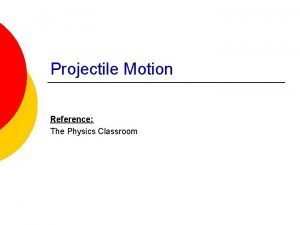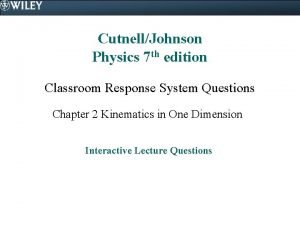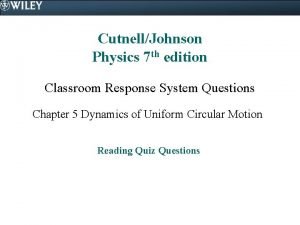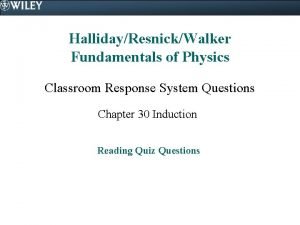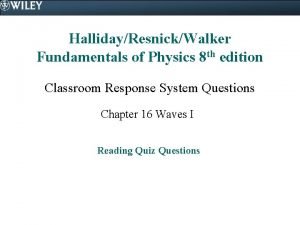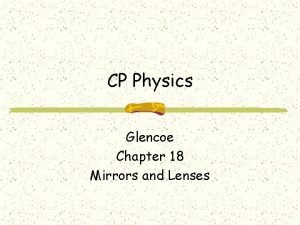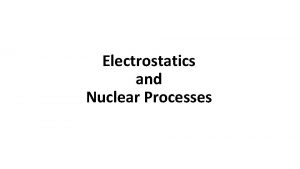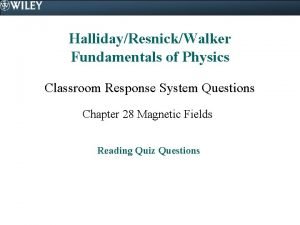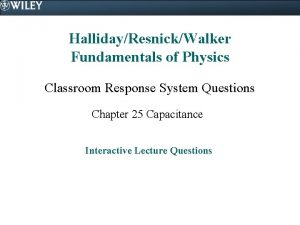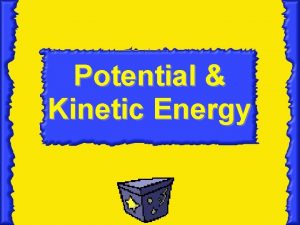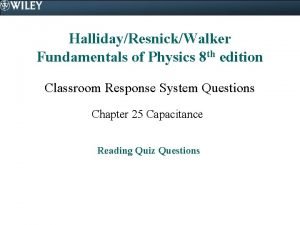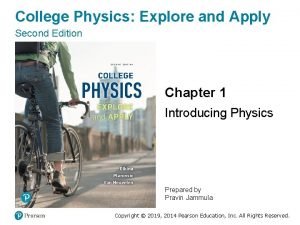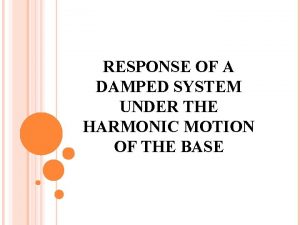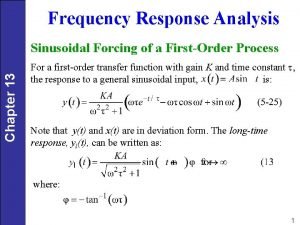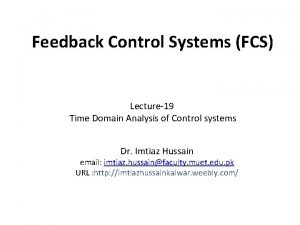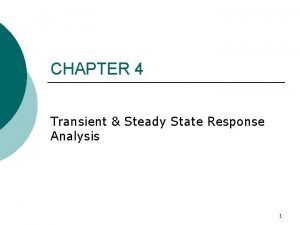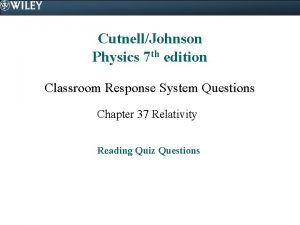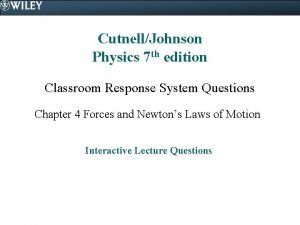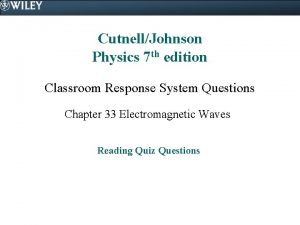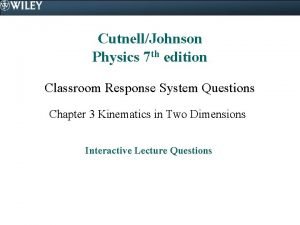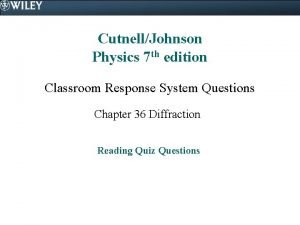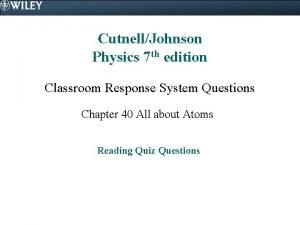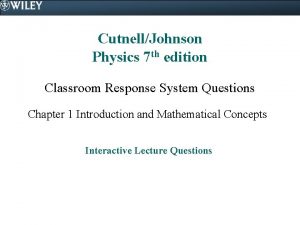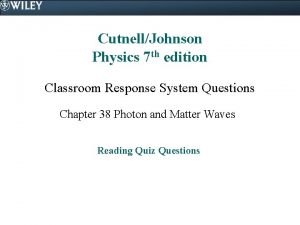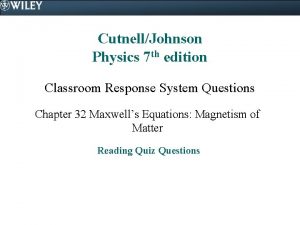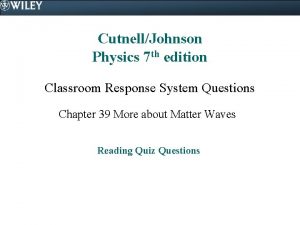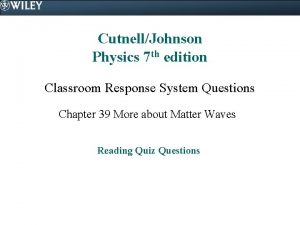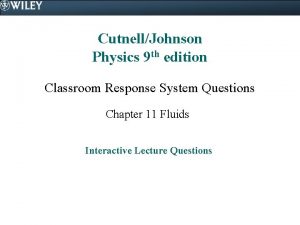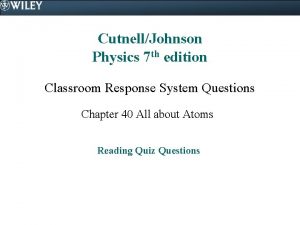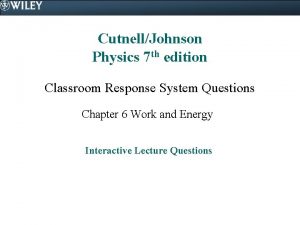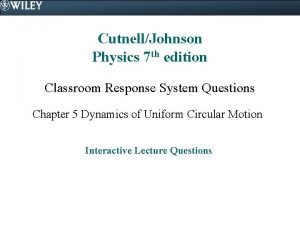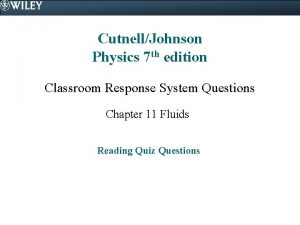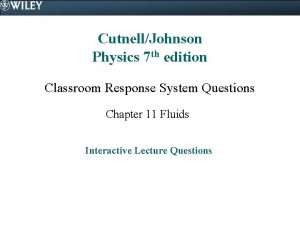CutnellJohnson Physics 7 th edition Classroom Response System





































- Slides: 37

Cutnell/Johnson Physics 7 th edition Classroom Response System Questions Chapter 12 Temperature and Heat Interactive Lecture Questions

12. 1. 1. Three thermometers are used to measure the temperature inside a closed, insulated box. Thermometer A is calibrated in Fahrenheit degrees, thermometer B in Celsius degrees, and thermometer C in Kelvins. When thermometers reach thermal equilibrium with the interior of the box, B reads 40 C and C reads 233 K. Which one of the following statements is necessarily true? a) Thermometer C should read 233 K. b) Thermometer A must read – 40 °F. c) If the temperature of the interior of the box is increased until A reads 20 F, thermometer B will read 10 C. d) Thermometer B should read 77 C. e) If the temperature of the interior of the box is increased until C reads 293 K, thermometer A will read 36 F.

12. 1. 1. Three thermometers are used to measure the temperature inside a closed, insulated box. Thermometer A is calibrated in Fahrenheit degrees, thermometer B in Celsius degrees, and thermometer C in Kelvins. When thermometers reach thermal equilibrium with the interior of the box, B reads 40 C and C reads 233 K. Which one of the following statements is necessarily true? a) Thermometer C should read 233 K. b) Thermometer A must read – 40 °F. c) If the temperature of the interior of the box is increased until A reads 20 F, thermometer B will read 10 C. d) Thermometer B should read 77 C. e) If the temperature of the interior of the box is increased until C reads 293 K, thermometer A will read 36 F.

12. 1. 2. Unsatisfied with the Celsius and Fahrenheit temperature scales, you decide to create your own. On your temperature scale, the ice point is 77 M and the steam point is at 437 M, where “M” stands for “my scale. ” What temperature on your scale corresponds to 68 F? a) 154 M b) 168 M c) 140 M d) 136 M e) 149 M

12. 1. 2. Unsatisfied with the Celsius and Fahrenheit temperature scales, you decide to create your own. On your temperature scale, the ice point is 77 M and the steam point is at 437 M, where “M” stands for “my scale. ” What temperature on your scale corresponds to 68 F? a) 154 M b) 168 M c) 140 M d) 136 M e) 149 M

12. 2. 1. Unsatisfied with the Celsius and Kelvin temperature scales, you decide to create your own. On your temperature scale, the ice point is 0. 0 M and the steam point is at 366. 1 M, where “M” stands for “my scale. ” What temperature on your scale corresponds to 0 K? a) 273. 1 M b) 500. 0 M c) 1000. 0 M d) 732. 4 M e) 633. 9 M

12. 2. 1. Unsatisfied with the Celsius and Kelvin temperature scales, you decide to create your own. On your temperature scale, the ice point is 0. 0 M and the steam point is at 366. 1 M, where “M” stands for “my scale. ” What temperature on your scale corresponds to 0 K? a) 273. 1 M b) 500. 0 M c) 1000. 0 M d) 732. 4 M e) 633. 9 M

12. 3. 1. Which one of the following properties is not likely to be used as a temperature-sensitive property to construct a thermometer? a) The volume of a liquid increases with increasing temperature. b) A gas held within a constant volume container exhibits pressure changes with corresponding temperature changes. c) The length of a metal rod changes linearly with temperature. d) The mass of a solid decreases with increasing temperature. e) The electrical resistance of a wire increases with increasing temperature.

12. 3. 1. Which one of the following properties is not likely to be used as a temperature-sensitive property to construct a thermometer? a) The volume of a liquid increases with increasing temperature. b) A gas held within a constant volume container exhibits pressure changes with corresponding temperature changes. c) The length of a metal rod changes linearly with temperature. d) The mass of a solid decreases with increasing temperature. e) The electrical resistance of a wire increases with increasing temperature.

12. 4. 1. An artist wishes to insert a gold pin into a hole in an iron sculpture and have it held permanently. The pin is slightly larger than the hole. The coefficient of linear thermal expansion of gold is slightly larger than that of iron. Consider the following options: (1) increase the temperature of the pin and the sculpture by the same amount, (2) decrease the temperature of the pin and the sculpture by the same amount, (3) increase the temperature of the pin and decrease the temperature of the sculpture, and (4) decrease the temperature of the pin and increase the temperature of the sculpture. Which of the choices would most likely accomplish the artist’s task? a) 1 b) 2 c) 3 d) 4 e) 2 and 4

12. 4. 1. An artist wishes to insert a gold pin into a hole in an iron sculpture and have it held permanently. The pin is slightly larger than the hole. The coefficient of linear thermal expansion of gold is slightly larger than that of iron. Consider the following options: (1) increase the temperature of the pin and the sculpture by the same amount, (2) decrease the temperature of the pin and the sculpture by the same amount, (3) increase the temperature of the pin and decrease the temperature of the sculpture, and (4) decrease the temperature of the pin and increase the temperature of the sculpture. Which of the choices would most likely accomplish the artist’s task? a) 1 b) 2 c) 3 d) 4 e) 2 and 4

12. 4. 2. The length of an aluminum pendulum in a certain clock is 0. 2480 m on a day when the temperature is 23. 30 C. This length was chosen so that the period of the pendulum is exactly 1. 000 s. The clock is then hung on a wall where the temperature is 5. 00 C and set to the correct local time. Assuming the acceleration due to gravity is the same at both locations, by how much time is the clock incorrect after one day at this temperature? a) 69. 3 s b) 115 s c) 87. 2 s d) 31. 0 s e) 11. 5 s

12. 4. 2. The length of an aluminum pendulum in a certain clock is 0. 2480 m on a day when the temperature is 23. 30 C. This length was chosen so that the period of the pendulum is exactly 1. 000 s. The clock is then hung on a wall where the temperature is 5. 00 C and set to the correct local time. Assuming the acceleration due to gravity is the same at both locations, by how much time is the clock incorrect after one day at this temperature? a) 69. 3 s b) 115 s c) 87. 2 s d) 31. 0 s e) 11. 5 s

12. 4. 3. A rod of length L is heated so that its temperature increases by T. As a result, the length of the rod increases by L. The rod is then cut into two pieces, one of length L/3 and one of length 2 L/3. What is the ratio of the change in length of the rod of length 2 L/3 to L of the original rod when its temperature is increased by T? a) 1/3 b) 2/3 c) 1 d) 3/2 e) 3

12. 4. 3. A rod of length L is heated so that its temperature increases by T. As a result, the length of the rod increases by L. The rod is then cut into two pieces, one of length L/3 and one of length 2 L/3. What is the ratio of the change in length of the rod of length 2 L/3 to L of the original rod when its temperature is increased by T? a) 1/3 b) 2/3 c) 1 d) 3/2 e) 3

12. 5. 1. Which one of the following statements is the best explanation for the fact that metal pipes that carry water often burst during cold winter months? a) Both the metal and the water expand, but the water expands to a greater extent. b) Water contracts upon freezing while the metal expands at lower temperatures. c) The metal contracts to a greater extent than the water. d) The interior of the pipe contracts less than the outside of the pipe. e) Water expands upon freezing while the metal contracts at lower temperatures.

12. 5. 1. Which one of the following statements is the best explanation for the fact that metal pipes that carry water often burst during cold winter months? a) Both the metal and the water expand, but the water expands to a greater extent. b) Water contracts upon freezing while the metal expands at lower temperatures. c) The metal contracts to a greater extent than the water. d) The interior of the pipe contracts less than the outside of the pipe. e) Water expands upon freezing while the metal contracts at lower temperatures.

12. 5. 2. Consider the four blocks made from the same material that are shown in the drawing. The sides have lengths of L, 2 L, or 3 L. Rank these blocks according to their expected increase, largest to smallest, in their volumes when their temperatures are increased by the same amount. a) B > C > A > D b) C > B > A > D c) D > C > A > B d) C > D > B > A e) All would have the same increase in volume.

12. 5. 2. Consider the four blocks made from the same material that are shown in the drawing. The sides have lengths of L, 2 L, or 3 L. Rank these blocks according to their expected increase, largest to smallest, in their volumes when their temperatures are increased by the same amount. a) B > C > A > D b) C > B > A > D c) D > C > A > B d) C > D > B > A e) All would have the same increase in volume.

12. 7. 1. A certain amount of heat Q is added to materials A, B, and C. The masses of these three materials are 0. 04 kg, 0. 01 kg, and 0. 02 kg, respectively. The temperature of material A increases by 4. 0 C while the temperature of the other two materials increases by only 3. 0 C. Rank these three materials from the largest specific heat capacity to the smallest value. a) A > B > C b) C > B > A c) B > A > C d) B = C > A e) A > B = C

12. 7. 1. A certain amount of heat Q is added to materials A, B, and C. The masses of these three materials are 0. 04 kg, 0. 01 kg, and 0. 02 kg, respectively. The temperature of material A increases by 4. 0 C while the temperature of the other two materials increases by only 3. 0 C. Rank these three materials from the largest specific heat capacity to the smallest value. a) A > B > C b) C > B > A c) B > A > C d) B = C > A e) A > B = C

12. 7. 2. A swimming pool has a width of 9. 0 m and a length of 12. 0 m. The depth of the water is 1. 83 m. One morning, the temperature of the pool water was 15. 0 C. The water then absorbed 2. 00 109 J of heat from the Sun. What is the final temperature of the water? Assume no heat loss to the surroundings. a) 16. 9 C b) 18. 1 C c) 17. 4 C d) 19. 6 C e) 20. 2 C

12. 7. 2. A swimming pool has a width of 9. 0 m and a length of 12. 0 m. The depth of the water is 1. 83 m. One morning, the temperature of the pool water was 15. 0 C. The water then absorbed 2. 00 109 J of heat from the Sun. What is the final temperature of the water? Assume no heat loss to the surroundings. a) 16. 9 C b) 18. 1 C c) 17. 4 C d) 19. 6 C e) 20. 2 C

12. 7. 3. Which of the following substances would be the most effective in cooling 0. 300 kg of water at 98 C? a) 0. 100 kg of lead at 22 C b) 0. 100 kg of water at 22 C c) 0. 100 kg of glass at 22 C d) 0. 100 kg of aluminum at 22 C e) 0. 100 kg of copper at 22 C

12. 7. 3. Which of the following substances would be the most effective in cooling 0. 300 kg of water at 98 C? a) 0. 100 kg of lead at 22 C b) 0. 100 kg of water at 22 C c) 0. 100 kg of glass at 22 C d) 0. 100 kg of aluminum at 22 C e) 0. 100 kg of copper at 22 C

12. 7. 4. Britanny’s normal body temperature is 36. 5 C. When she recently became ill, her body temperature increased to 38. 0 C. What was the minimum amount of heat required for this increase in body temperature if her weight is 561 N? a) 2. 96 106 J b) 3. 50 103 J c) 4. 98 104 J d) 3. 00 105 J e) 7. 60 105 J

12. 7. 4. Britanny’s normal body temperature is 36. 5 C. When she recently became ill, her body temperature increased to 38. 0 C. What was the minimum amount of heat required for this increase in body temperature if her weight is 561 N? a) 2. 96 106 J b) 3. 50 103 J c) 4. 98 104 J d) 3. 00 105 J e) 7. 60 105 J

12. 7. 5. Four 1 -kg cylinders are heated to 100 C and placed on top of a block of paraffin wax, which melts at 63 C. There is one cylinder made from lead, one of copper, one of aluminum, and one of iron. After a few minutes, it is observed that the cylinders have sunk into the paraffin to differing depths. Rank the depths of the cylinders from deepest to shallowest. a) lead > iron > copper > aluminum b) aluminum > copper > lead > iron c) aluminum > iron > copper > lead d) copper > aluminum > iron > lead e) iron > copper > lead > aluminum

12. 7. 5. Four 1 -kg cylinders are heated to 100 C and placed on top of a block of paraffin wax, which melts at 63 C. There is one cylinder made from lead, one of copper, one of aluminum, and one of iron. After a few minutes, it is observed that the cylinders have sunk into the paraffin to differing depths. Rank the depths of the cylinders from deepest to shallowest. a) lead > iron > copper > aluminum b) aluminum > copper > lead > iron c) aluminum > iron > copper > lead d) copper > aluminum > iron > lead e) iron > copper > lead > aluminum

12. 8. 1. Heat is added to a substance, but its temperature does not increase. Which one of the following statements provides the best explanation for this observation? a) The substance has unusual thermal properties. b) The substance must be cooler than its environment. c) The substance must be a gas. d) The substance must be an imperfect solid. e) The substance undergoes a change of phase.

12. 8. 1. Heat is added to a substance, but its temperature does not increase. Which one of the following statements provides the best explanation for this observation? a) The substance has unusual thermal properties. b) The substance must be cooler than its environment. c) The substance must be a gas. d) The substance must be an imperfect solid. e) The substance undergoes a change of phase.

12. 8. 2. What is the final temperature when 2. 50 105 J are added to 0. 950 kg of ice at 0. 0 C? a) 0. 0 C b) 4. 2 C c) 15. 7 C d) 36. 3 C e) 62. 8 C

12. 8. 2. What is the final temperature when 2. 50 105 J are added to 0. 950 kg of ice at 0. 0 C? a) 0. 0 C b) 4. 2 C c) 15. 7 C d) 36. 3 C e) 62. 8 C

12. 8. 3. By adding 25 k. J to solid material A, 4. 0 kg will melt. By adding 50 k. J to solid material B, 6. 0 kg will melt. Solid material C requires 30 k. J to melt 3. 0 kg. Which of these materials, if any, has the largest value for the heat of fusion? a) A b) B c) C d) A = B

12. 8. 3. By adding 25 k. J to solid material A, 4. 0 kg will melt. By adding 50 k. J to solid material B, 6. 0 kg will melt. Solid material C requires 30 k. J to melt 3. 0 kg. Which of these materials, if any, has the largest value for the heat of fusion? a) A b) B c) C d) A = B

12. 8. 4. Consider the system shown in the drawing. A test tube containing water is inserted into boiling water. Will the water in the test tube eventually boil? a) Yes, heat is continually transferred to the water inside the test tube and eventually it will boil? b) Yes, the pressure above the water in the test tube will be reduced to less than atmospheric pressure and cause the water to boil. c) No, heat will only be transferred until the water in the test tube is 100 C. d) No, the temperature of the water in the test tube will never reach 100 C.

12. 8. 4. Consider the system shown in the drawing. A test tube containing water is inserted into boiling water. Will the water in the test tube eventually boil? a) Yes, heat is continually transferred to the water inside the test tube and eventually it will boil? b) Yes, the pressure above the water in the test tube will be reduced to less than atmospheric pressure and cause the water to boil. c) No, heat will only be transferred until the water in the test tube is 100 C. d) No, the temperature of the water in the test tube will never reach 100 C.
 University physics with modern physics fifteenth edition
University physics with modern physics fifteenth edition 2know classroom response system
2know classroom response system Smart classroom vs traditional classroom
Smart classroom vs traditional classroom Using mis (10th edition) 10th edition
Using mis (10th edition) 10th edition Using mis (10th edition)
Using mis (10th edition) Natural and forced response
Natural and forced response Natural response and forced response example
Natural response and forced response example Primary immune response and secondary immune response
Primary immune response and secondary immune response Hewitt
Hewitt Physics classroom
Physics classroom Centripetal acceleration physics classroom
Centripetal acceleration physics classroom Hanging sign problem physics
Hanging sign problem physics Unit of flux
Unit of flux Consider the three equations below.
Consider the three equations below. Physics classroom lenses and mirrors
Physics classroom lenses and mirrors Electrostatics physics classroom
Electrostatics physics classroom Gauss law physics classroom
Gauss law physics classroom Physics classroom magnetic field
Physics classroom magnetic field Capacitance physics classroom
Capacitance physics classroom Physics classroom kinetic energy
Physics classroom kinetic energy Farad is equivalent to
Farad is equivalent to College physics: explore and apply answers
College physics: explore and apply answers Modern physics vs classical physics
Modern physics vs classical physics Physics hl ia examples
Physics hl ia examples Principles of palaycheck system
Principles of palaycheck system Computer system architecture 3rd edition
Computer system architecture 3rd edition Operating system concepts, 10th edition
Operating system concepts, 10th edition Operating system concepts 6th edition
Operating system concepts 6th edition Chords rule in dbms
Chords rule in dbms The american system of criminal justice 16th edition
The american system of criminal justice 16th edition What are the branches of criminal justice system
What are the branches of criminal justice system Interactive voice response system randomization
Interactive voice response system randomization Smartboard response clickers
Smartboard response clickers Damped system under harmonic force
Damped system under harmonic force Herds reporting
Herds reporting Sinusoidal response of first order system
Sinusoidal response of first order system The impulse signal imitate the
The impulse signal imitate the Steady state response example
Steady state response example








